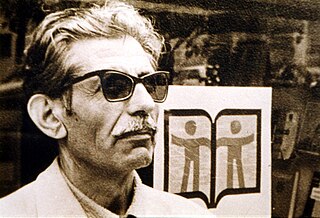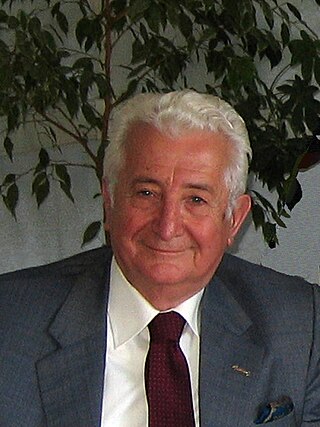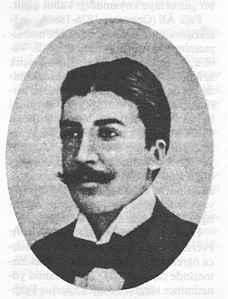Related Research Articles
The culture of Turkey or the Turkish culture combines a heavily diverse and heterogeneous set of elements that have been derived from the various cultures of the Eastern European, Eastern Mediterranean, Caucasian, Middle Eastern and Central Asian traditions. Many of these traditions were initially brought together by the Ottoman Empire, a multi-ethnic and multi-religious state spanning across Southern Europe, Eastern Europe, the Middle East and North Africa.
Turkish literature comprises oral compositions and written texts in the Turkish language. The Ottoman form of Turkish, which forms the basis of much of the written corpus, was highly influenced by Persian and Arabic literature, and used the Ottoman Turkish alphabet.

Orhan Veli Kanık or Orhan Veli was a Turkish poet. Kanık is one of the founders of the Garip Movement together with Oktay Rıfat and Melih Cevdet. Aiming to fundamentally transform traditional form in Turkish poetry, he introduced colloquialisms into the poetic language. Besides his poetry, Kanık crammed a large volume of works including essays, articles and translations into just 36 years.
Varlık is a monthly Turkish literature and art magazine. Established by Yaşar Nabi Nayır, Sabri Esat Siyavuşgil, and Nahit Sırrı Örik in 1933, it often publishes poetry and works of famous Turkish poets and writers.
There were a number of poetic trends in the poetry of Turkey in the early years of the Republic of Turkey. Authors such as Ahmed Hâşim and Yahyâ Kemâl Beyatlı (1884–1958) continued to write important formal verse whose language was, to a great extent, a continuation of the late Ottoman tradition. By far the majority of the poetry of the time, however, was in the tradition of the folk-inspired "syllabist" movement, which had emerged from the National Literature movement and which tended to express patriotic themes couched in the syllabic meter associated with Turkish folk poetry.
Ali Oktay Rifat, better known as Oktay Rifat, was a Turkish writer and playwright, and one of the forefront poets of modern Turkish poetry since the late 1930s. He was the founder of the Garip movement, together with Orhan Veli and Melih Cevdet.

Melih Cevdet Anday was a Turkish writer whose poetry stands outside the traditional literary movements. He also wrote in many other genres which, over six and a half decades, included eleven collections of poems, eight plays, eight novels, fifteen collections of essays, several of which won major literary awards. He also translated several books from diverse languages into Turkish.

Behçet Necatigil ; He is a Turkish poet, teacher and translator. He is one of the leading poets of modern Turkish poetry.[5] He did not join any literary movement; He is an independent poet and intellectual.[6] Apart from poetry, he has produced works in many fields of literature, from theater to mythology, from lexicography to novel translations and radio plays. He contributed greatly to the adoption of radiophonic play as a branch of literature in Turkey with his plays, translations and adaptations.[7] The artist, who is known as the "Poet of Houses", is also known for his identity as a teacher as well as his literary work.
The time that can be called contemporary in Turkish literature falls in the period between the middle of the 20th century and the first years of the new millennium. Throughout this period many changes in literary discourse have occurred. Together with the fall of the Ottoman Empire and foundation of the Turkish Republic brought a different way to Turkish literature together with the effect of Westernization on Turkish writers. The literature of the new republic emerged largely from the pre-independence National Literature movement, with its roots simultaneously in the Turkish folk tradition and in the Western notion of progress. One important change to Turkish literature was enacted in 1928, when Mustafa Kemal initiated the creation and dissemination of a modified version of the Latin alphabet to replace the Arabic-based Ottoman script. Over time, this change—together with changes in Turkey's system of education— would lead to more widespread literacy in the country. In 1950s, Turkish authors started to write in the tone of their western contemporaries bringing a new sense of literature to the country.

Oğuz Tansel was a Turkish poet and folklorist.

Orhan Karaveli was a Turkish journalist and writer.
Pembe Marmara was a Turkish Cypriot poet. She was one of the most important Turkish Cypriot poets of the 1940s and one of the earliest female Turkish Cypriot poets. Her poetry was influenced heavily by the Garip movement in Turkey and she wrote works of satire in free verse. Her poetry is also distinct from the nationalism characterising Turkish Cypriot poetry of her time, instead focusing more on the experience of being a Turkish Cypriot.
Derman İskender Över, also known as Küçük İskender, was a Turkish poet, critic and actor.

Cenâb Şehâbeddîn, was a Turkish poet and writer. He was one of the leading representatives of Servet-i Fünûn literature.
Gevheri Turkish: Gevherî was a Turkish folk poet who is estimated to have lived in the 17th century. In 1998, In the work titled "Gevherî Divanı", published by Şükrü Elçin, 945 poems of the poet included in the cönks and manuscripts were brought together.
Yaprak was a biweekly magazine published in Ankara, Turkey, between 1949 and 1951. It is known for its founder and editor-in-chief Orhan Veli Kanık, a Turkish poet. The title of the magazine was a reference to its format since it was published on a single sheet.
Yeditepe was a literary magazine which was published in Istanbul, Turkey, from 1950 to 1984 with a five-year interruption. Its title was a reference to both Istanbul and seven arts or traditional subdivision of the arts. It was one of the opposition media outlets in the 1950s and also, an influential literary magazine during its run.
References
- ↑ Durmuş, Mitat (December 2009). "Problematization of Tradition in the Context of Garip Poetry". Yeni Türk Edebiyatı Araştırmaları: 1. Archived from the original on 25 May 2024. Retrieved 25 May 2024.
- ↑ Çetin, Nurullah; Sakallı, Fatih; Karataş, Cengiz, eds. (2021). Republican Period Turkish Literature (1st ed.). Ankara: İlbilge Publishing. p. 97. ISBN 978-605-74157-0-7.
- 1 2 3 4 5 6 7 Çetin, Nurullah; Sakallı, Fatih; Karataş, Cengiz, eds. (2021). Republican Period Turkish Literature (1st ed.). Ankara: İlbilge Publishing. p. 98. ISBN 978-605-74157-0-7.
- ↑ Şahan, Kayhan (September 2018). "Metaphors and Orhan Veli's Poetry". International Journal of Turkish Literature Culture Education. 7 (3): 1823. Archived from the original on 25 May 2024. Retrieved 25 May 2024.
- 1 2 Gökalp, Gonca (July 1993). "Republican Period Turkish Poetry and Behçet Necatigil". Hacettepe University Journal of the Faculty of Literature. 10 (1): 354–355. Archived from the original on 5 August 2022. Retrieved 25 May 2024.
- ↑ Gökalp, Gonca (July 1993). "Republican Period Turkish Poetry and Behçet Necatigil". Hacettepe University Journal of the Faculty of Literature. 10 (1): 356. Archived from the original on 5 August 2022. Retrieved 25 May 2024.
- ↑ Geçgel, Hulusi (June 2024). "Hayal Kültür Sanat Edebiyat Dergisi" (PDF). Hayal Yayıncılık (21): 2. Archived from the original (PDF) on 10 May 2024. Retrieved 24 May 2024.
- ↑ Turan GÖKÇE; Ayşe Güher GÜLAÇAR, eds. (2022). "Tek Parti Dönemi Edebi Akım, Grup ve Topluluklarına İzmirli Edebiyatçıların Katkıları" (PDF). ŞEHİR KÜLTÜR MEDENİYET: ÇAKA BEY'DEN GÜNÜMÜZE İZMİR. Vol. 4. İzmir Katip Çelebi Üniversitesi. p. 1843. Archived from the original (PDF) on 25 May 2024. Retrieved 25 May 2024.
- ↑ Tekmen, Ayşe Nur (2010). "Japon şiiri haiku ve Türk Edebiyatındaki Yansıması" (PDF). Ankara Üniversitesi Dil ve Tarih-Coğrafya Fakültesi Türkoloji Dergisi. Archived from the original (PDF) on 25 May 2024. Retrieved 25 May 2024.
- ↑ Bakır, Sinan (1 January 2021). "Garip Ve İkinci Yeni Şiirinin Kaynakları". DEDE KORKUT Uluslararasi Turk Dili ve Edebiyati Arastirmalari Dergisi. 10 (25): 8. doi:10.25068/dedekorkut423. ISSN 2147-5490.